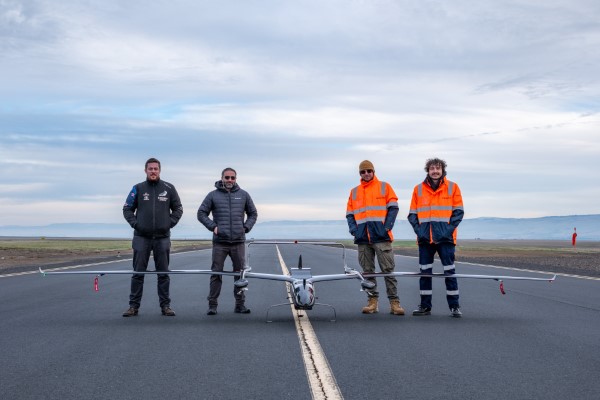Three years into Oregon’s 10-year Innovation Plan the state has already distributed more than $50 million toward targeted industry innovation and entrepreneurial support.
The state’s economic development agency Business Oregon has been intent on ensuring that all of its communities have the resources in place to aid new business development, while establishing the space needed for innovation to take flight.
With millions in motion around the state, the ripple effect of these investments are sparking innovation in even the most rural regions of Oregon. Behind-the-scenes footwork of local businesses, educational institutions, organizations and agencies to cultivate healthy partnerships and industry ecosystems means that all that an entrepreneur needs to show up with is their ideas.
Innovation Acceleration
Thanks to a $2.25 million grant from Business Oregon received in September 2023, aerospace testing ground Pendleton UAS Range (PUR) unveiled a new accelerator program just five months later to boost innovation in the Unmanned Aircraft Systems market.
PUR was one of five organizations selected to form the Oregon Innovation Council (Oregon InC) Centers of Innovation Excellence. The remaining $6.75 million in grant funding goes toward four centers covering bioscience, materials science & chemistry, semiconductors and additive manufacturing.
To build upon the success PUR has found in the testing and development of UAS, the grant award naturally led to the creation of the Oregon UAS Accelerator, which plans to welcome seven startups to its initial cohort beginning in June 2024.
“While the Pendleton UAS Range has been a focal point for UAS testing due to its extensive 14,000-square-mile test site, the accelerator program enhances this setup by providing a structured ecosystem to nurture and support startups,” says Oregon UAS Accelerator Executive Director Joseph Wyno. “With dedicated curriculum, facilities, mentorship and funding, we are poised to attract and accelerate the development of promising unmanned systems startups, fostering a thriving innovation ecosystem in Oregon.”
By keeping this and future cohorts small it allows for each startup to gain personalized attention, resources and mentorship. Startups selected out of what Wyno calls an “outstanding and oversubscribed” applicant pool are in store for fully funded perks.
To kick off the program, participants will automatically receive a $40,000 non-dilutive grant toward business needs. During the course of the program these startups gain access to PUR’s test sites, offices, workspaces and state-of-the-art equipment such as 3D printers and mission control centers.
The industry itself comes with significant costs and by removing financial and operational barriers this center allows innovators to focus solely on product development and growth. In figuring out how to fill a crucial gap in UAS activity taking place at PUR, the creation of this initiative tackles multiple challenges. Aside from the space and equipment, participants will be able to collaborate with PUR’s network of industry partners and have the opportunity to showcase and pitch their products to investors in the September 2024 Pendleton Investor Round-Up event.
“Previously, while the range offered outstanding testing, flight and ground facilities, startups often lacked a comprehensive support system to refine their solutions, secure funding and engage with industry investors and partners,” says Wyno. “The accelerator bridges this gap by offering a holistic programmatic curriculum that guides startups through critical stages of development, investor readiness and market entry.”
In April 2024, Business Oregon and Oregon Innovation Council announced a fresh $2.6 million toward the state’s nine Regional Innovation Hubs: Cascades West, Central Oregon, Frontier Oregon, Metro Region, Mid-Columbia, Mid-Willamette Valley, South-Central Oregon, Southern Oregon and the Southwest Oregon Innovation Network.
But why just have Centers of Innovation Excellence when you can have Regional Innovation Hubs as well? When it comes to key strategies listed in the state’s 10-year Innovation Plan, establishing these hubs will be invaluable to reaching entrepreneurs throughout Oregon.
Many of these Regional Innovation Hubs cover three or more Oregon counties, which makes this funding vital to supporting a consistent stream of innovation. Although these centers primarily focus on startups within science and technology, one can find support for a variety of industries. Whether it be technical assistance, looking to raise capital, networking, mentorship or talent development, these Regional Hubs are in place to ensure resources are never far from reach.
Small Town Support
Out in Oregon’s rural communities, grant funding through Business Oregon’s Technical Assistance (TA) program has been a game changer for awakening a new age of entrepreneurial ventures.
Logistically, the lifestyle rural and downright frontier Oregon offers isn’t ideal for everyone, which makes attracting new business difficult. For High Desert Partnership’s Biz Harney Collaborative Coordinator and SBDC Business Advisor Andrea Letham, the solution to this challenge in a frontier community of 7,515 residents like Harney County is to build new businesses at home.
One of the most daunting aspects of becoming an entrepreneur is knowing how to get started. Aside from Harney County, there are many small communities in eastern Oregon that simply didn’t have the resources to give the proper support and attention these startups need.
This made the arrival of Business Oregon’s TA program the perfect opportunity to build a network of small business support in the region. In the initial 2021-23 biennium of this program, High Desert Partnership (HDP) was awarded $750,000 to bring technical assistance services to five counties — Harvey, Baker, Union, Wallowa and Malheur. HDP’s partners include the Burns Paiute Tribe, Northeast Oregon Economic Development District, EUVALCREE, Oregon Frontier Chamber of Commerce and Launch Pad Baker.
“Through that we were able to service 679 unique clients, 2,701 one-on-one technical assistance meetings, and 3,300 cohort trainings. Which is huge,” says Letham. “That created 133 jobs and launched 61 businesses, resulting in over $2.5 million in capital.”
When Business Oregon returned last year with an additional $350,000, the new funding allowed for these partnerships to grow. HDP serves as a connection point to distribute funding to its regional partners, allowing these communities to use the resource in a way that best supports their individualized community needs.
In Harney and Malheur counties, the first round of funding allowed HDP to introduce K-12 business education curriculum for students to learn each step that goes into turning an idea into a profitable and scalable business. On the advice of Reinventing Rural’s Brad Attig, HDP began administering a 10-week entrepreneurial course called CO.STARTERS in mid-2021, catering to residents looking to receive one-on-one technical assistance to develop business plans and engage with local business owners. With an over 90% success rate in Harney County and a number of new businesses created as a result of this course, this program now extends to the community’s youth.
“Our goal is not just to get you a business start,” says Letham. “Our goal is to make sure that your business starts and stays.”
Business Oregon’s Economic Equity Investment Program grants $3,000 to
$5,000 to qualifying entrepreneurs
to start a business.
For a small community that, as Letham jokes, “has more cattle than people,” continuous support from the state allows for smaller Eastern Oregon communities to create opportunity to keep talent at home. From the largest to smallest of scale, the years of targeted funding execution have taught Business Oregon and organizations like HDP exactly which and where resources are most beneficial to residents.
With newer initiatives like Business Oregon’s Economic Equity Investment Program, which grants $3,000 to $5,000 in funding to qualifying entrepreneurs to start a business, even the most rural of communities can gain access to new avenues of capital support.
“Our entrepreneurial ecosystem is vibrant and booming, and needs continual support and nourishment,” says Letham. “A high percentage of jobs that are provided in the state are small businesses. So, it only makes sense that funding is given to support them.”


